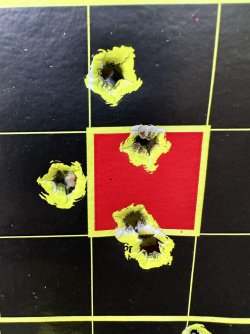Just shot this right now. 300 NMI with 215 Berger's. First seating depth and charge weight.
100 yards. Mounted new scope. Bore sighted. Shot these 5 shots. Adjusted zero afterwards.
View attachment 585658
Went straight to 957 yards with the next 5 shots to true drop data. Holding 2 MOA of wind.
View attachment 585660
I've done this with all of my rifles with different bullets and powders enough times to know it works. Now in 10 rounds, I have a gun and load with the precision capable of killing anything well beyond 1000 yards. So instead of doing development to shrink my group .1 (which is extremely hard to even prove that you succeeded in doing), and will also have a 0% effect on whether or not I kill an animal. Now I can just get to shooting and making sure my drops are perfect and repeatable beyond 1200 yards. No cold bore shifts (which there never is). Practicing in wind and testing some better positional shooting, all of which can actually have an impact on whether or not I kill an animal.

